Running can feel like a love-hate relationship, right? One minute you’re soaring down the pavement like a gazelle, and the next, you’re gasping for air while contemplating your life choices. Whether you’re a seasoned marathoner or just starting out on your running journey, there are some golden nuggets of wisdom that can help make your runs more enjoyable and effective. So, lace up those sneakers, and let’s dive into some fantastic running tips!
Top Takeaways and Key Concepts
Choose the right running shoes to prevent injuries and improve comfort and performance.
Warm up dynamically before running to prepare muscles and boost performance.
Listen to your body and rest when needed to prevent pain and long-term injury.
Hydrate properly before and during runs to maintain energy and avoid cramps.
Set realistic goals and vary your routes to stay motivated and make progress.
Summary of This Article
This article offers practical and motivating tips to make running more enjoyable, safe, and effective. It emphasizes starting with the right gear—especially proper running shoes—to support your feet and prevent injuries. A good running routine includes warming up with dynamic stretching, cooling down afterward, and staying hydrated for optimal performance. The article also stresses the importance of listening to your body to avoid pushing through pain, setting realistic and achievable goals to stay motivated, and mixing up running routes to prevent boredom. With these smart strategies, runners of all levels can improve both their performance and their love for the sport.
Video Summary
Find Your Perfect Pair of Shoes
Please Note: This post may contain affiliate links. If you click one of them, we may receive a commission at no extra cost to you. As an Amazon Associate, I earn from qualifying purchases.
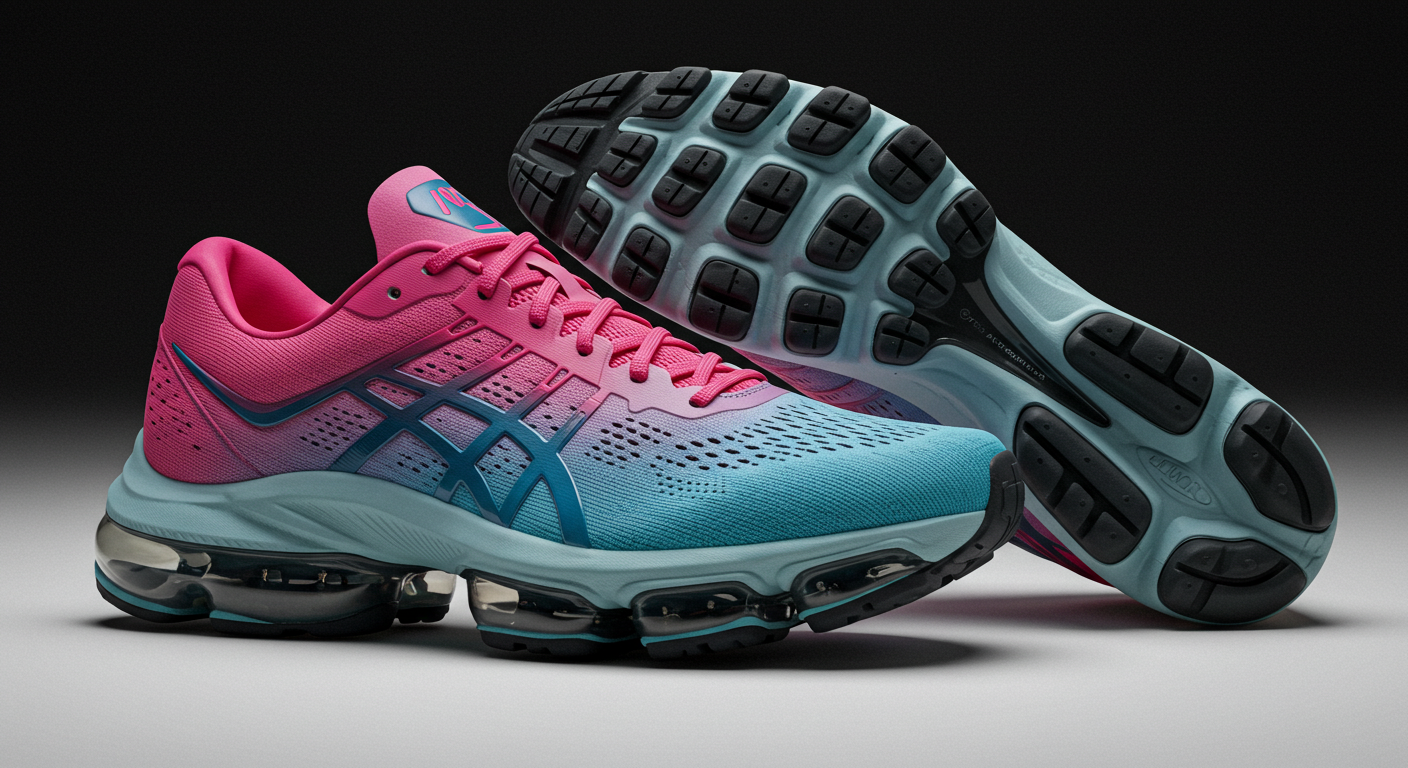
Shortcuts to Exercise Equipment Shopping at Amazon
Ellipticals - Exercise Bikes - Recumbent Bikes - Treadmills - Rowers
Dumbbells - Resistance Bands - Kettlebells - Benches - Pull-up Bars
🏋️♀️ When it comes to finding the perfect running shoes, did you know that some people actually run faster in mismatched shoes? It’s true! A study found that runners who wore one shoe from a brand and another from a different brand felt like they were breaking records. Maybe it’s all about the surprise factor—your feet just can’t predict what’s coming next! 🏋️♀️
“Running is about more than just putting one foot in front of the other; it’s about finding your stride.” — Oprah Winfrey
First things first, let’s speak about shoes! If you still run in your old sneakers from gym class in high school, it’s time to get a new pair. It’s really important to find the correct pair of running shoes because they can make or break your experience. You wouldn’t want to drive a car with flat tires, would you?
Going to a specialty store can make a big difference when it comes to picking out the best running shoes. These places have trained professionals who can look at your gait, which is a fancy way of saying how you run. They’ll observe you jog or walk on a treadmill and look at how you hit the ground, what kind of arch you have, and how your body moves in general. It’s like having a coach who knows just what you need. Who would have thought that buying shoes could be so scientific?
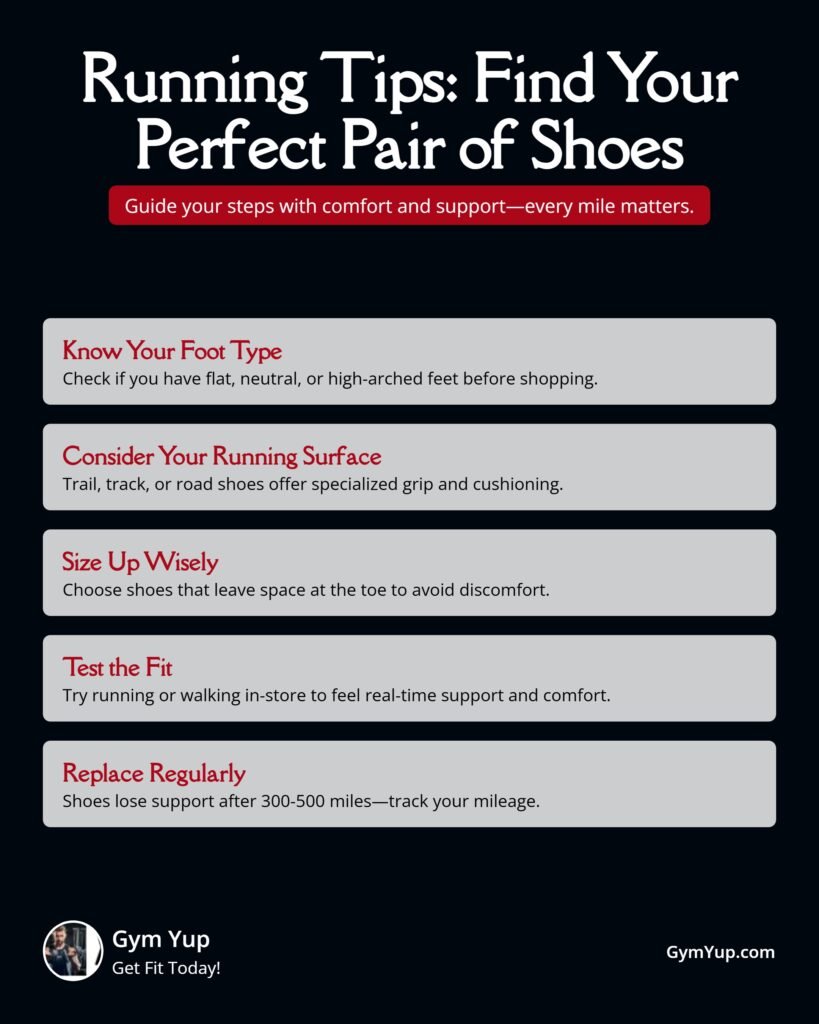
Now, let’s discuss about the many kinds of feet. Everyone’s feet are different. Some people have high arches that look like the arcs of a roller coaster, while others have flatter feet that look more like pancakes. The correct shoe will give you support where you need it most, whether that is cushioning for your bouncing arches or stability for your flat feet. Finding this ideal fit is like running into your sweetheart at a coffee shop: it happens out of the blue and makes you feel great!
When you find the perfect shoes that fit your feet perfectly and make you feel like you’re walking on clouds (or maybe even marshmallows), there’s one important thing to remember: how long they will last! Running shoes usually lose their magic abilities after 300 to 500 km. Every mile you walk or run puts stress on the cushioning and support that is supposed to keep your joints and muscles safe. If you push them too far, it’s like trying to drive a car with bald tires—you’ll get into problems!
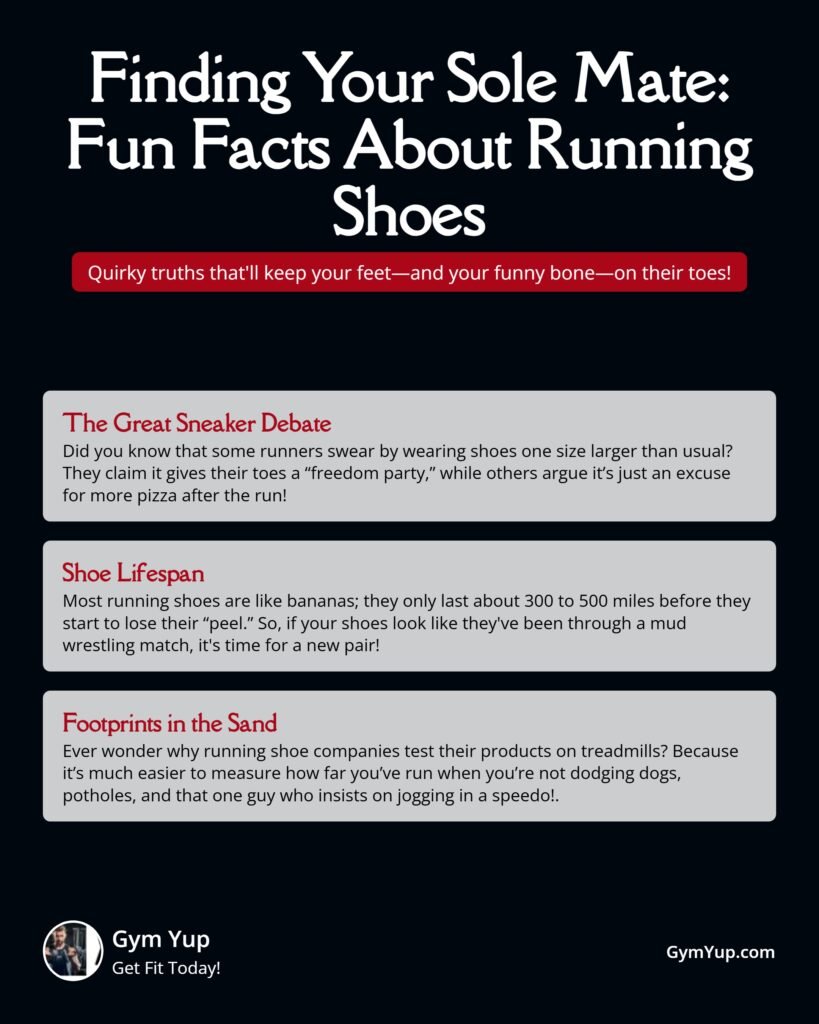
If you run about 20 miles a week, which is relatively normal for a lot of runners, those shoes will only last about four months before you need to get new ones. I mean, no one wants to get hurt faster than I do when I trip over my own feet while running to the ice cream truck! So remember to keep note of how many miles you drive or just write down the day you bought them.
Don’t skimp on getting the ideal pair of running shoes. Go to that specialty store and get ready for some individualized guidance just for you! And once you’ve found “the one,” take good care of them by keeping an eye on their mileage. No one wants to get hurt and have to stop jogging when they could be having fun!
Warm-Up Like a Pro
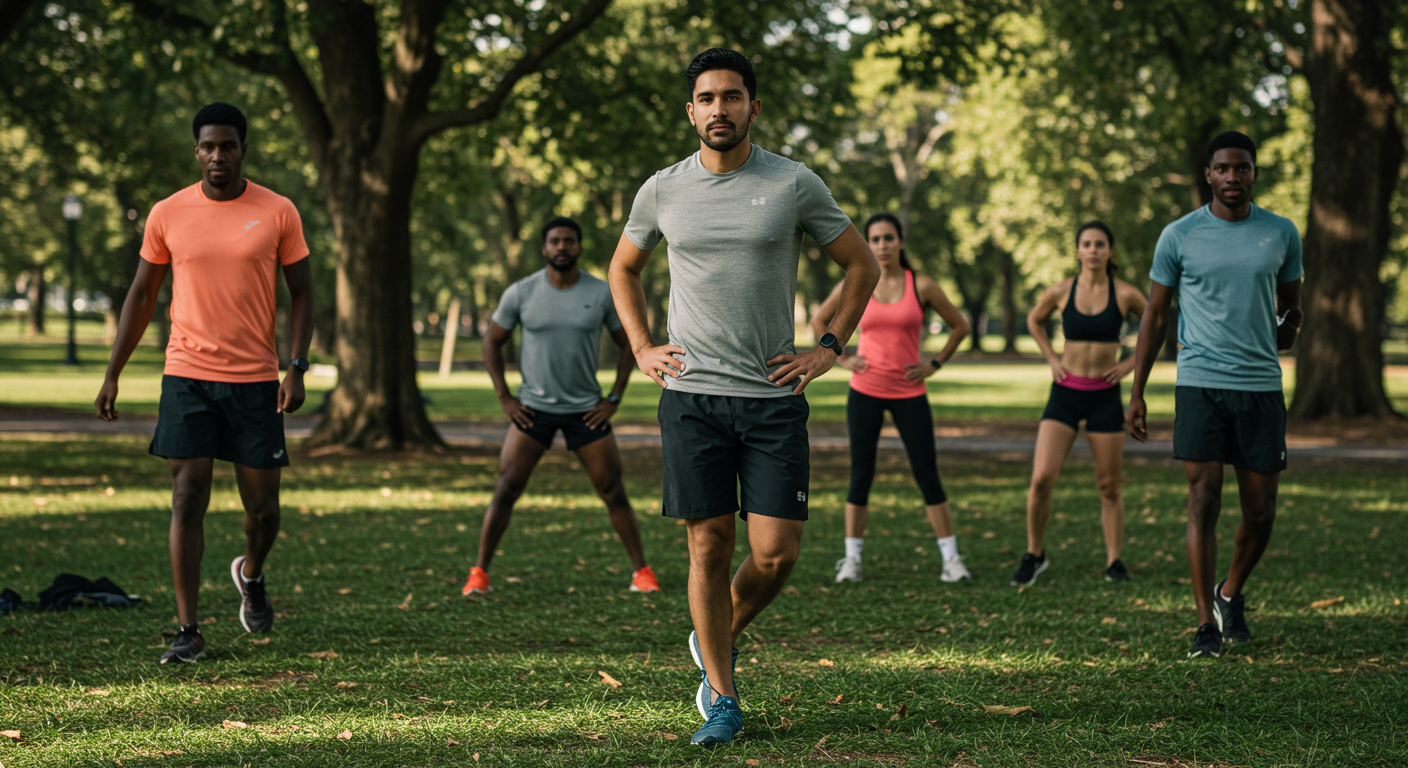
🏋️♀️ Before a big run, some elite athletes will actually do “dynamic stretching” that looks like an interpretive dance routine gone wrong. Think high knees, leg swings, and lunges that could easily be mistaken for a scene from a quirky musical! This not only warms up their muscles but also makes them feel like they’re auditioning for Broadway. 🏋️♀️
“Success is where preparation and opportunity meet.” — Bobby Unser
Now that you have the correct shoes on, let’s talk about how to warm up. I know what you’re thinking: “Warm-up? Isn’t that merely stretching? Not really! Warming up is a must if you want to get your muscles and joints ready to work. Think of it as getting ready for a big fight (or at least a fun run around the block).
Let’s speak about warming up before you put on your running shoes and hit the road. I mean, who wants to feel like a rusty robot when they start running? Believe me, beginning cold is a sure way to fail. Instead, start your workout with some dynamic stretches that will make you feel loose and ready to take on the world, or at least the park next door.
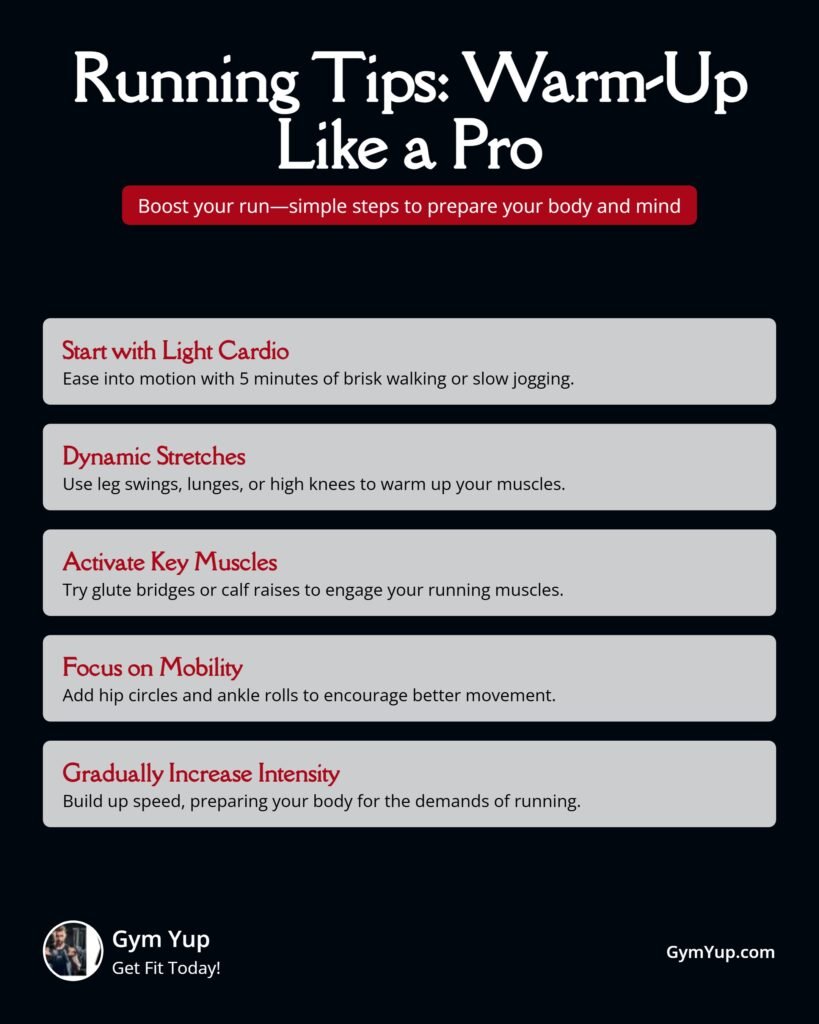
Dynamic stretches are the best thing you can do here. You could call them the fitness universe’s warm-up superheroes. Leg swings are great! Hold on to something strong, like a fence or even a friendly tree, and swing one leg back and forth. Not only is it beneficial for your legs, but it also gets your hips moving. You might appear a little ridiculous, but we all have our own idiosyncrasies, right? Then there are arm circles. Stretch your arms out wide and produce small circles that get bigger with time. This move warms up your shoulders without the risk of turning you into a pretzel, unless you really try hard!
It’s time to start your run once you’ve done some dynamic stretching and gotten your blood flowing. It is very important to slowly pick up the tempo because going straight to full speed can leave you gasping for air faster than I can find my keys when I’m late! To give your body time to adjust, start with a short jog or brisk stroll. It’s not only about avoiding damage; warming up those muscles also helps you do better.
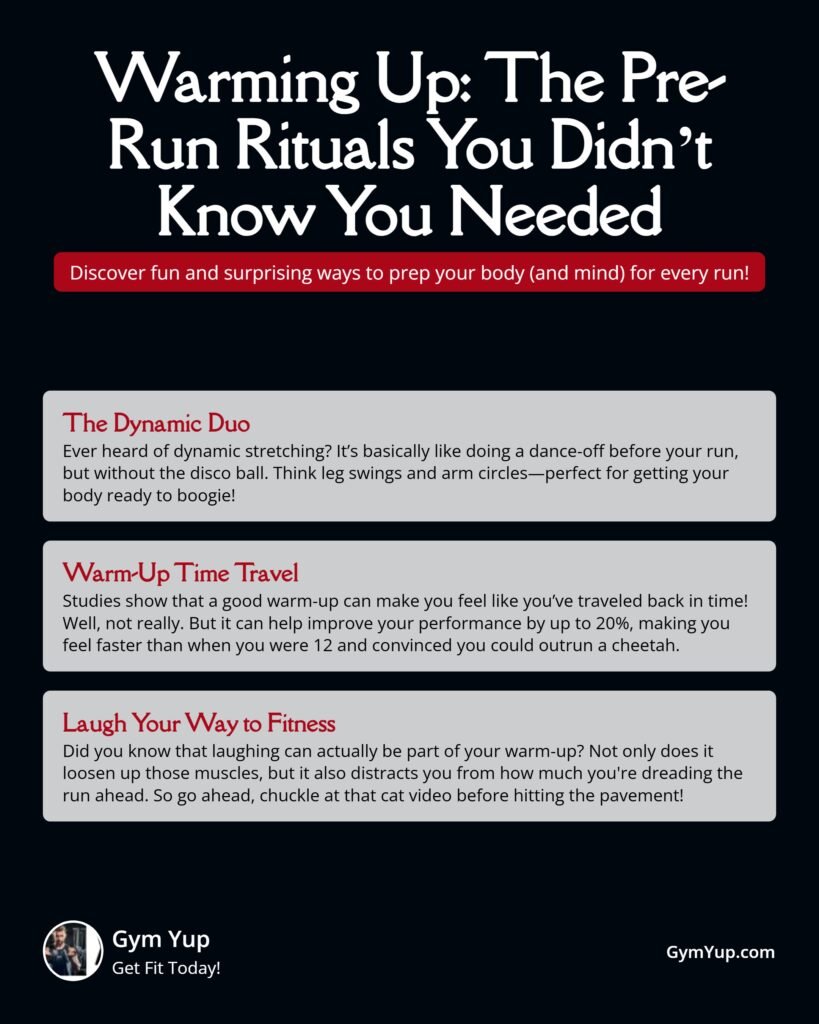
Pay attention to your body while you warm up. If something feels tight or painful—maybe that old knee injury is whispering sweet nothings in your ear—it would be a good idea to slow down before you speed up. Honestly, no one wants to feel like they’re banging into a brick wall after only a few minutes of running!
When you’ve built up enough speed and feel like you’re gliding instead of dragging along like a tired turtle, it’s time to let your inner cheetah out! Slowly pick up the pace until you’re running at maximum speed. This will help you stay energized during your workout and make you less tired later.
So keep in mind that you should do dynamic stretches first, then slowly speed up before jumping into the exciting world of running. Your body will thank you later when you cross the finish line instead of being hurt because you skipped the warm-up dance party!
Listen to Your Body
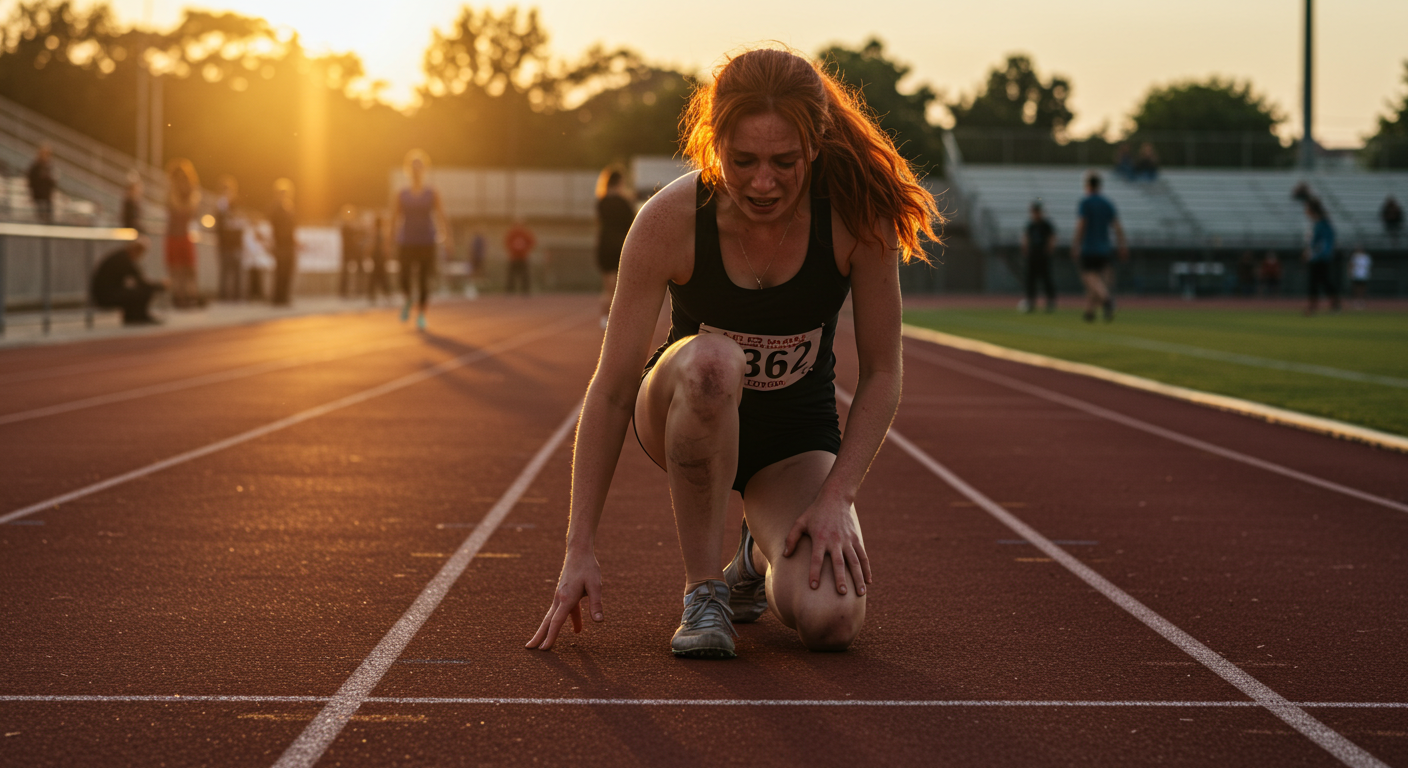
🏋️♀️ Did you know that your body can actually produce a sound when you’re running? It’s called “runner’s high,” but it’s not just the endorphins talking—some people report hearing their own joints creak and pop like a bag of popcorn! So, if you hear strange noises while jogging, don’t worry; it’s just your body trying to join the conversation. 🏋️♀️
“Your body hears everything your mind says.” — Naomi Judd
It’s important to listen to your body so you don’t strike walls. Have you ever been halfway through a run and had anything seem wrong? It could be that twinge in your knee or a cramp that comes out of nowhere. If you ignore these signs, it’s like ignoring smoke alarms. Trust me, it never ends good.
Let’s be honest for a moment. One minute, running might feel like a beautiful dance with the wind, and the next, it can feel like you’re stumbling in quicksand. When you’re out there pounding the pavement, it’s important to pay attention to how your body feels. Your body is trying to tell you something, and ignoring those signals can hurt you and keep you out of action longer than my last attempt at putting together IKEA furniture. Trust me on this!
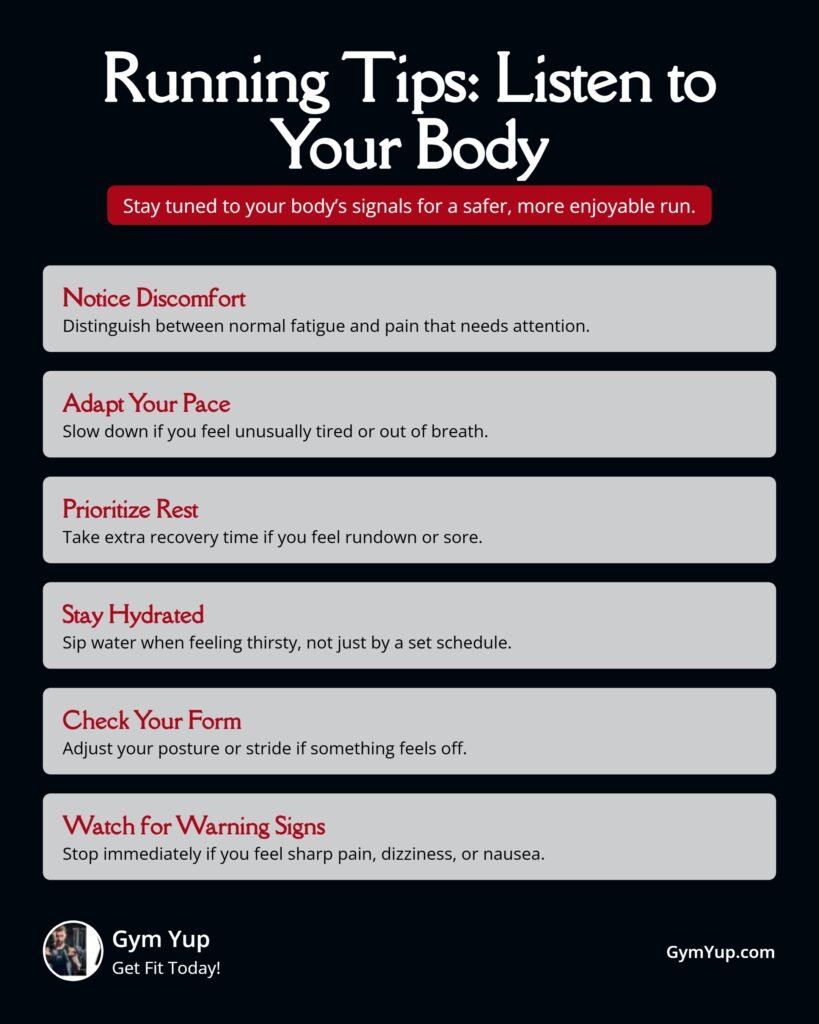
I really mean it when I say “slow down.” If you’re in pain, there’s no shame in letting up on the gas pedal. Maybe that knee is sending you bad feelings, or your hip feels tighter than my trousers after Thanksgiving dinner. Whatever it is, don’t be a hero; just take a break! It’s much better to stop for a few minutes now than to keep going and risk getting hurt, which may keep you off the route for weeks or even months.
The running community has this great saying: “You’ll be back stronger!” And to be honest? It couldn’t be more right. It’s not just about becoming better when you take time off; it’s also about coming back ready to crush those miles like they owe you money! Instead of feeling bad about taking a break or slowing down, consider of it as a necessary stop on your way to greatness.
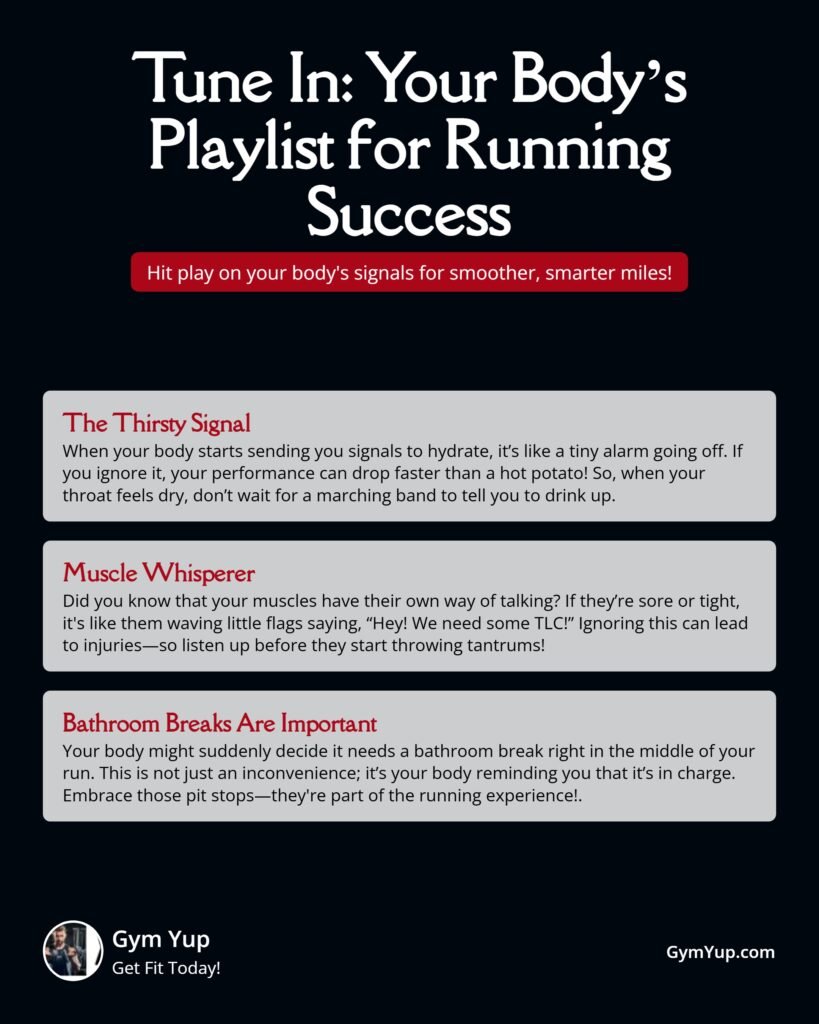
But let’s not fool ourselves. You might want to use this free time to binge-watch Netflix, especially when the new season of your favorite program comes out (you know which one I’m talking about!). It’s okay to spend some time on the sofa every now and then, but remember that rest should include mild stretches or light walking instead of long streaming sessions. Even a little activity will be good for your muscles!
So the next time you’re out for a run and things start to seem off, trust your gut. Take it easy, take a break if you need to, and let yourself put recuperation ahead of pushing through the discomfort. When you’re back on track—faster, stronger, and ready for whatever experiences come your way—you’ll be glad you did. And think of all the great stories you’ll have about how you listened to your body instead of becoming another cautionary story in the world of running!
Hydration Is Everything

🏋️♀️ Did you know that the average human body is about 60% water? That means if you’re not hydrating properly, you could be running around like a walking raisin! So, next time you forget to drink water before your run, just remember: nobody wants to be the dehydrated fruit in the fruit salad of life. 🏋️♀️
“Water is the driving force of all nature.” — Leonardo da Vinci
How well we run depends a lot on how well we stay hydrated. Imagine being thirsty after just ten minutes out there. It’s not a good look! Staying hydrated helps keep cramps away and gives you more energy during those longer runs.
Drinking enough water while jogging is like adding the secret sauce to a great burger; it makes everything better! If you want to feel like a superhero as you run, start by drinking water before you even put on your shoes. It’s like getting ready for a party, except instead of shots, it’s all about drinking water. I mean, who wants to feel like a dry sponge when they’re attempting to drive on the open road? Not me!
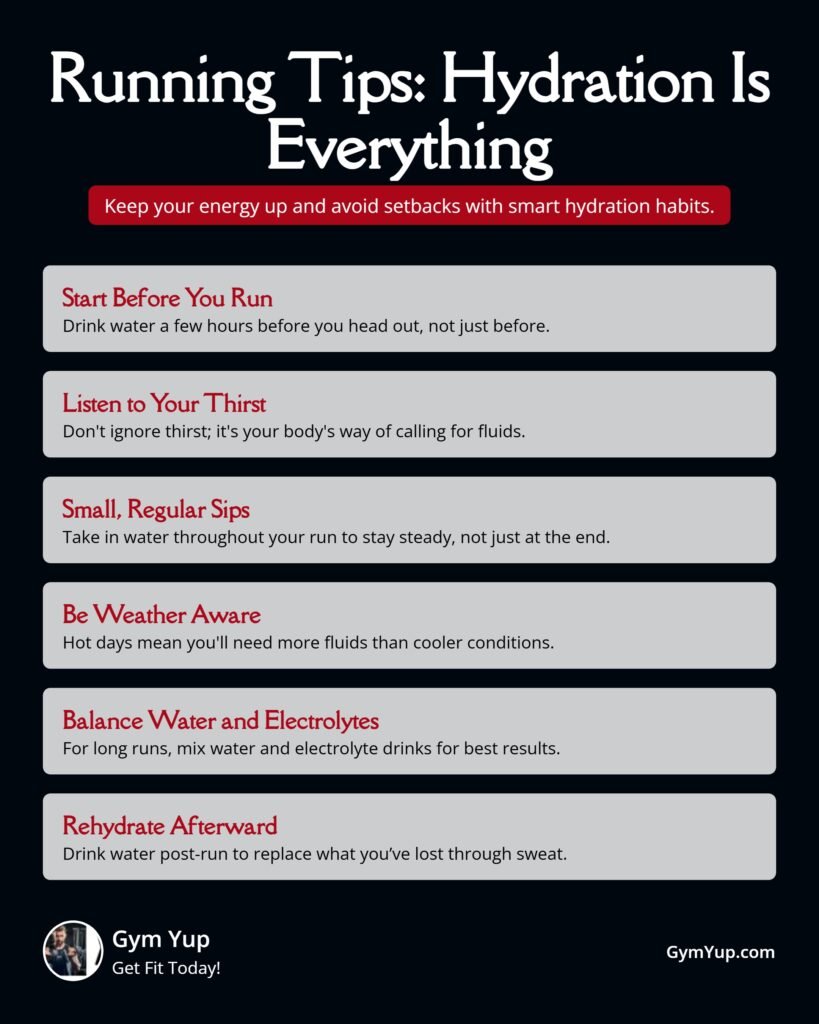
Once you’re out there sweating buckets in the hot sun—because let’s face it, jogging can make anyone a human sprinkler—you’ll want to keep drinking water. It’s very important! Your body is like a car engine. If you don’t give it enough fluids, it will overheat and stop working faster than my Wi-Fi does during peak hours. So get that water bottle and sip it slowly while you run. There doesn’t have to be a chugging contest every five minutes; just keep it going.
What if plain ordinary water becomes as boring as watching paint dry? That makes perfect sense! If you think plain water is boring (and who could blame you?), why not add some flavor to it? You may make your hydration more interesting without adding extra calories by adding lemon slices or fresh berries. Imagine sipping delightful sips of lemon or strawberry-flavored drinks. It’s like giving your taste buds a mini-vacation while still doing something good for your body!

Adding taste to your water can make you want to drink more since who wouldn’t want their hydration regimen to feel like a trip to a fancy spa? Fruits like berries are also full of vitamins and antioxidants that will help you get well faster after those lengthy runs. You’re not only soothing your thirst, but you’re also taking care of yourself.
Drink water before and during your session! And don’t be afraid to add some flavor to your beverages. Your body will appreciate you later when it’s powered by tasty drinks instead of plain old tap water. Now make drinking entertaining; after all, running is hard enough without making it boring too!
Set Realistic Goals

🏋️♀️ Studies show that if you set a goal to run a mile in under six minutes, your chances of achieving it are about as good as finding a unicorn at the grocery store. Instead, aim for “I will run to the mailbox without stopping” — because let’s be honest, even that can feel like an Olympic event some days! 🏋️♀️
“Goals are dreams with deadlines.” — Diana Scherling
Instead of trying to reach Olympic-level goals overnight, it’s better to create realistic goals depending on where you are right now. We all have huge dreams, but it’s simpler to build confidence along the road if you start small.
Setting realistic goals for running is like building a ladder to success, one step at a time. Instead of striving to break your own records every time you run, which can feel as hard as climbing Mount Everest without oxygen, why not set smaller, more achievable goals? For example, adding just half a mile to your distance each week can make a big difference. You need to take your time and let your body get used to it. If you set your goals too high too quickly, you could feel like a deflated balloon instead of flying into the air.
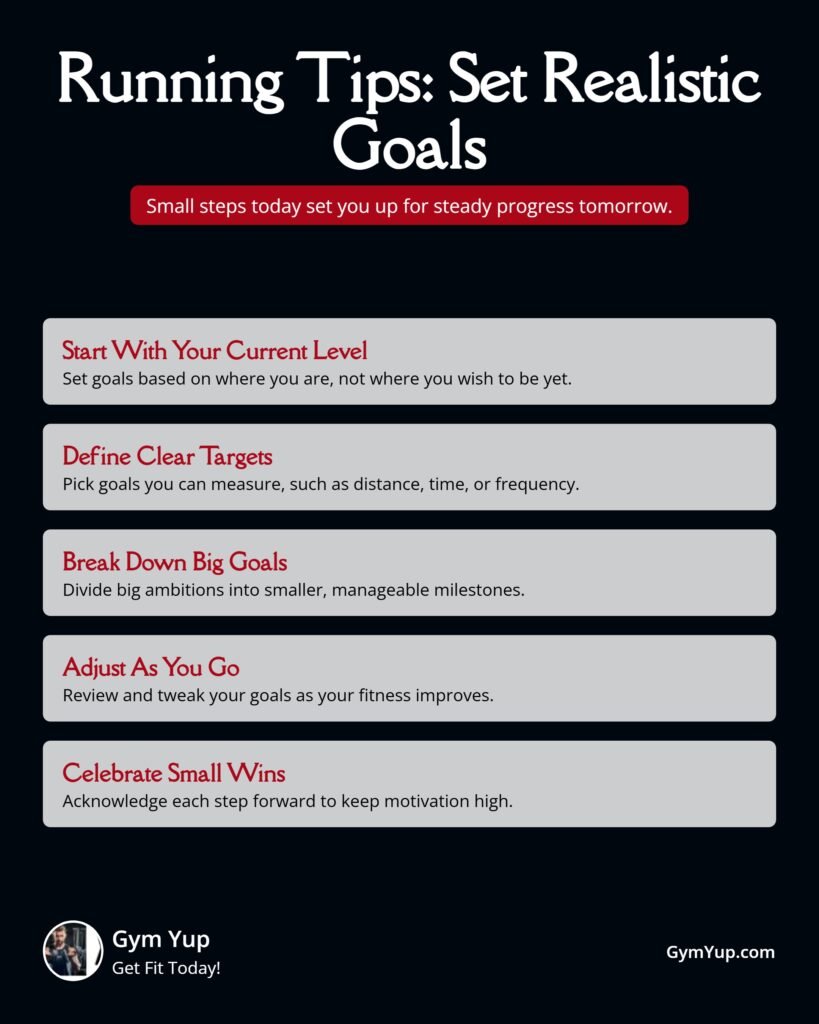
Another great milestone is to slowly get faster. Instead of running out of the gate like you’re in an Olympic final (we’ve all been there, right?), attempt to make small changes to your runs. You might one day push yourself just a little bit harder for the last quarter-mile or add short bursts of speed to your training. This method not only helps you avoid burnout, but it also keeps things new and fascinating! Also, it gives you something real to work toward instead of just wishing you could run faster.
Now let’s speak about how to celebrate those small wins. Who doesn’t love that warm, fuzzy sensation of success? When you reach a new distance or trim a few seconds off your pace, take a moment to give yourself a pat on the back. Better yet, treat yourself! These celebrations keep your motivation high and strong, whether it’s treating yourself to that nice coffee you’ve been eyeing or letting yourself watch an episode (or three) of your favorite program without feeling bad about it. They remind us that every little victory is part of the bigger picture.
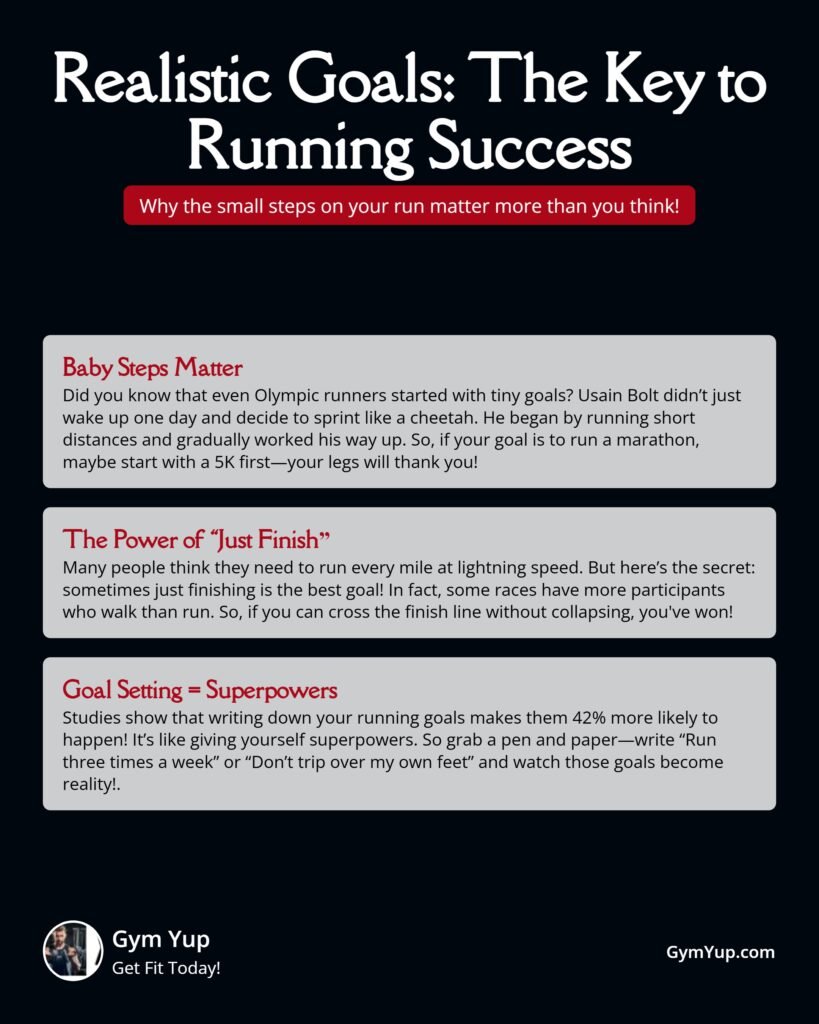
You don’t have to do big things to celebrate progress. Sometimes all you have to do is tell your friends or other runners about your accomplishments. People who see your posts on social media may inspire you and make you feel like you’re part of a community around your running adventure. Who knows? You might also encourage someone else to put on their shoes and go for a walk!
Running isn’t just about beating the clock; it’s also about having fun along the way. Setting realistic goals helps you feel good about yourself and keeps you from getting frustrated. And trust me, nothing feels better than knowing you’re making progress toward becoming a better version of yourself! So go ahead and put on those shoes, make some goals, and enjoy every little win as you run toward greatness!
Mix Up Your Routes
🏋️♀️ If you run the same route every day, your feet may start to develop a relationship with the pavement—so much so that they might even consider it their “sole mate.” Keep things spicy by exploring new paths and letting your feet experience different terrain, or they might just file for “sole custody.” 🏋️♀️
“Running is about finding your inner peace. And so is a life well lived.” — Dean Karnazes
If you start yawning in the middle of your run because you’ve seen the same trees too many times (seriously, how many times can one person admire bushes?), it could be time for something new! Changing up your routes keeps things interesting and works different muscle groups, plus it keeps boredom from setting in faster than my dog can grab snacks from my plate.
Finding new parks or trails to run on in your region can completely change how you run! Picture yourself putting on your shoes and starting off to find a beautiful trail you’ve never been on before. Every time you go outside, it’s like going on a little adventure. Changing your surroundings not only clears your mind, but it also makes things more interesting when they might otherwise get boring. Who wouldn’t want to give up the same old path for a beautiful one with colorful trees, singing birds, and maybe even a curious squirrel now and then?
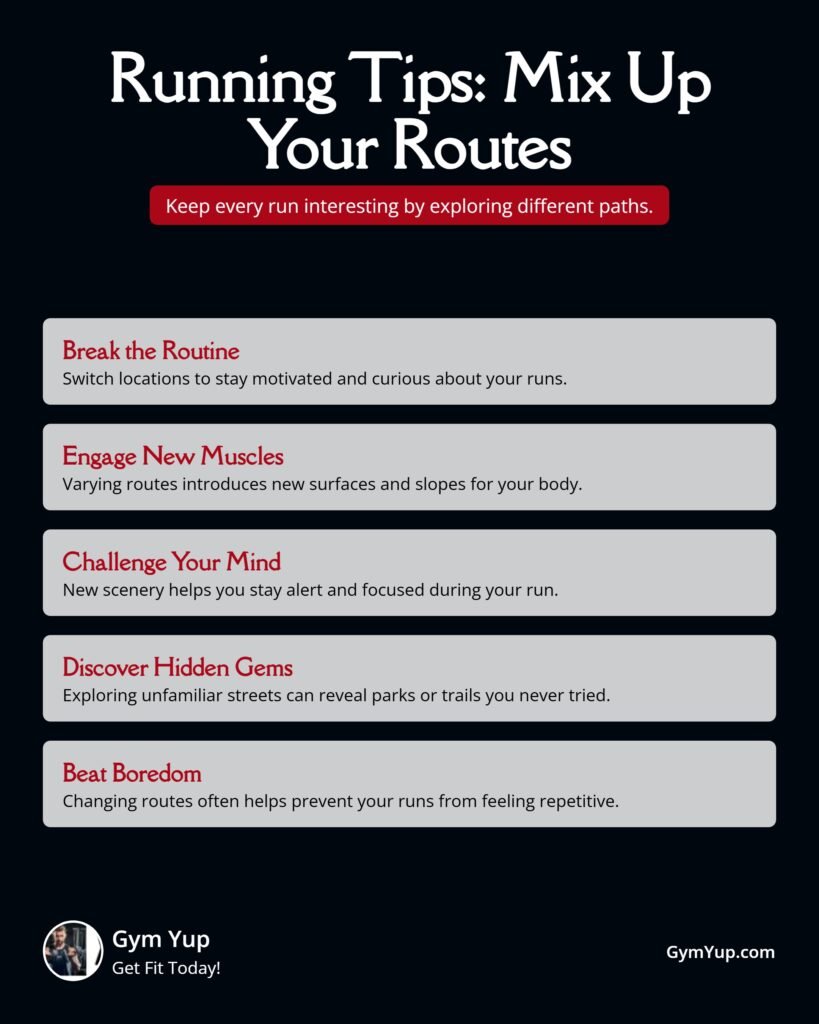
When you go for a run on the trails, you’re not just running; you’re taking in the beauty of nature. The sights and noises around you can naturally push you onward with each stride. I mean, have you ever run next to a lake that sparkles or through a forest that is full of sunlight? You can’t help but feel better in a place like this! Also, being outside makes you feel better, like Mother Nature is cheering you on.
Changing your surroundings can greatly improve your stamina over time. When you run on diverse types of terrain, like soft dirt trails, hard hills, or flat paved highways, you work out different muscle groups that you might not use as much when you run on a regular basis. This variation helps you get stronger and last longer than doing the same thing over and over again. It’s like finding hidden gems along the road. Each new course has its own set of obstacles and rewards that help you become a better runner.
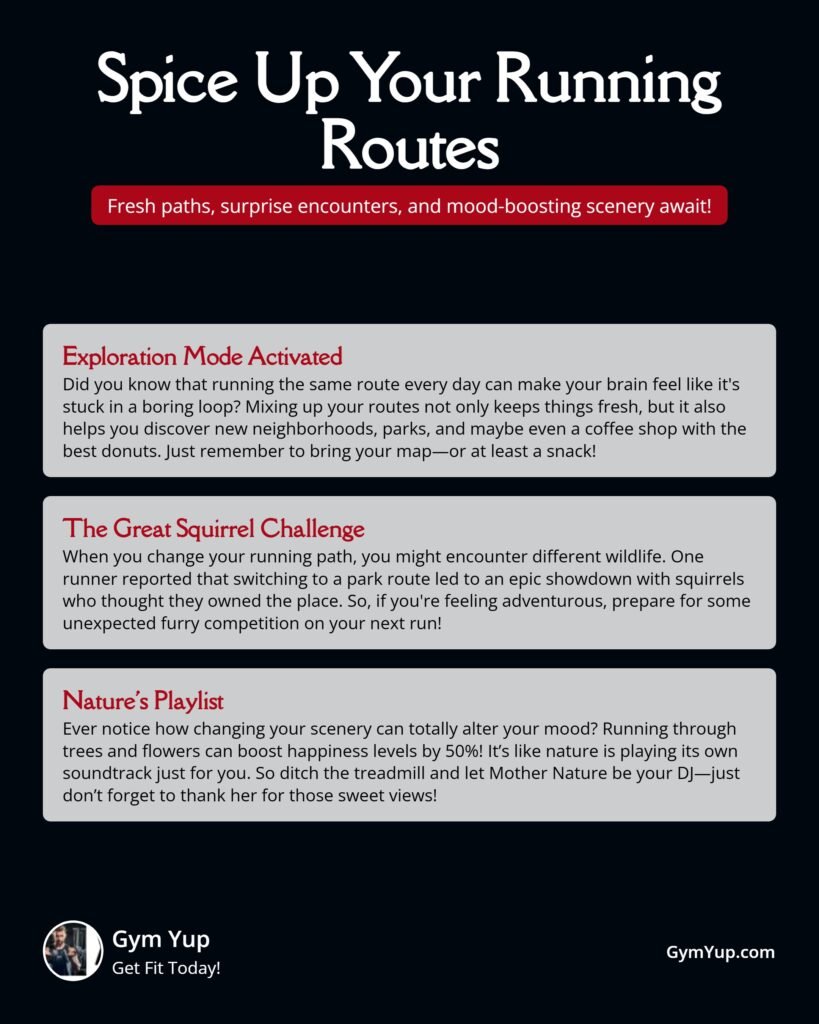
Finding different ways to get around can also help keep you from being hurt. Running on diverse surfaces keeps your muscles and joints from getting too much stress since you have to keep adapting to changing situations. You may think of it as cross-training without having to go to the gym. You will see that those small improvements make a big difference. They will not only help you run farther or faster, but they will also make the whole experience more fun.
To make this experience even more fun, think about asking friends or family to come along for the ride—or should I say run? Sharing these experiences can make for fun trips with lots of laughter and friendship that will keep everyone motivated. It’s also tougher to hit snooze on your alarm clock when you know someone else is counting on you to be at that gorgeous park before dawn for a jog.
So why not pack your things and go explore a new place? Finding new parks and trails is one of the easiest and most gratifying ways to make your running experience better. Every time you explore, you get new ideas and motivation. Who knows what amazing things you’ll see just around the next bend? Get those shoes on; adventure is waiting!
Cool Down & Stretch It Out
Finally—and this part is super important—don’t skip cooling down after finishing strong! Slowing down gradually allows heart rates to return safely while reducing soreness later on (no one likes feeling stiff).
Once cooled down completely (think leisurely stroll mode), dedicate some time to static stretching afterward; targeting major muscle groups will keep flexibility intact and help prevent injuries moving forward. Plus, taking care of our bodies means we can keep enjoying those exhilarating runs long-term!
Suggested Resources
The Ultimate Guide to Running
https://www.runnersworld.com/ultimate-guide-to-running
10 Essential Running Tips
https://www.active.com/running/articles/10-essential-running-tips
How To Choose the Right Running Shoes
https://www.rei.com/learn/expert-advice/running-shoes.html
Frequently Asked Questions
Why are proper running shoes so important?
Correct shoes support your feet, reduce joint stress, and can prevent injuries by matching your arch type and running mechanics.
Should runners warm up before starting a jog?
Yes, dynamic warm ups like leg swings and light jogging prepare muscles, increase circulation, and improve overall performance.
Is it bad to keep running through pain?
Ignoring sharp discomfort increases injury risk, so slowing down or resting when pain appears helps protect long term health.
How does hydration impact running performance?
Staying hydrated helps prevent cramps, supports energy levels, and keeps your body functioning efficiently during runs.
What are examples of realistic running goals?
Increasing mileage slowly or improving pace in small increments helps build confidence and steady progress without overload.
Why should runners change up their routes?
New routes challenge different muscles, reduce boredom, improve stamina, and help prevent overuse from repeating the same terrain.
Is a cool down necessary after every run?
Yes, cooling down and stretching help the body return to baseline, reduce soreness, and support injury prevention.

Kevin Collier is a passionate fitness expert dedicated to helping individuals achieve their health and wellness goals. With a focus on weight lifting, exercise routines, and effective weight loss strategies, he aims to inspire and motivate others on their fitness journeys. Through evidence-based insights and practical advice, Kevin empowers readers to make informed decisions about their health, encouraging a balanced approach to fitness and overall well-being. Whether you’re a beginner or an experienced athlete, his expertise offers valuable guidance to elevate your fitness game.




